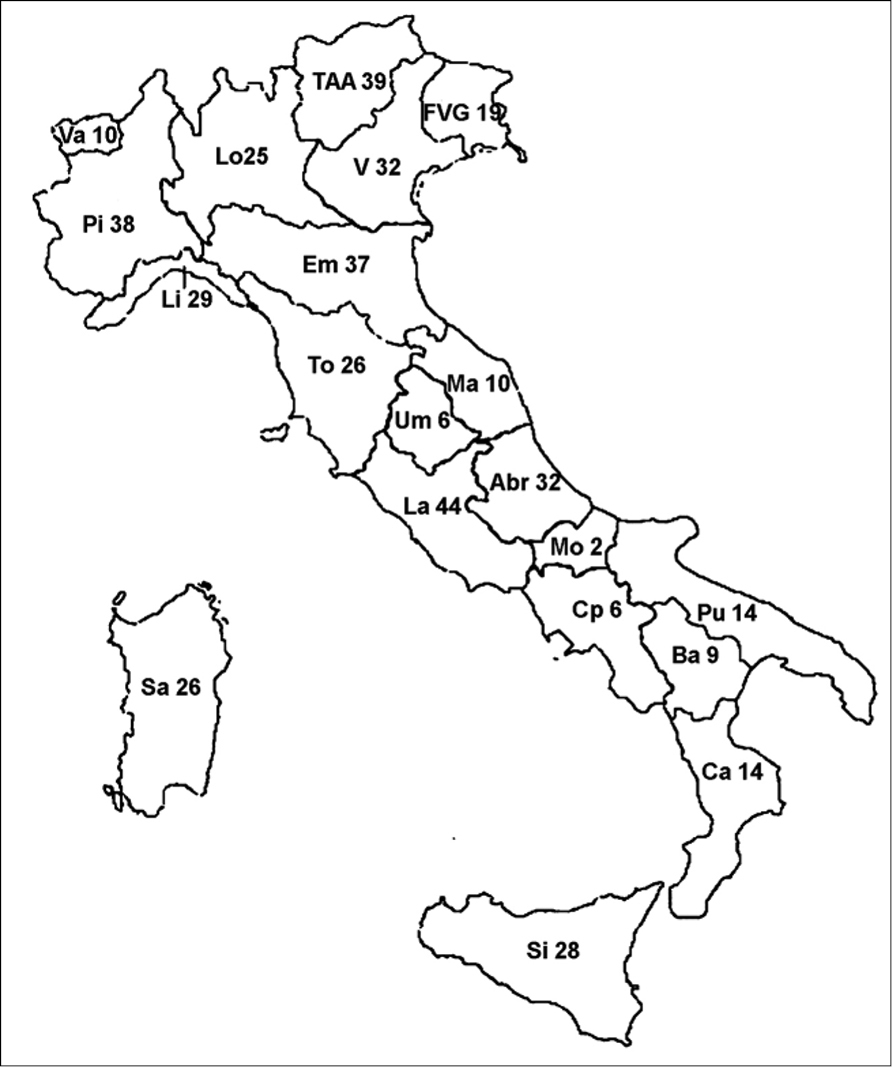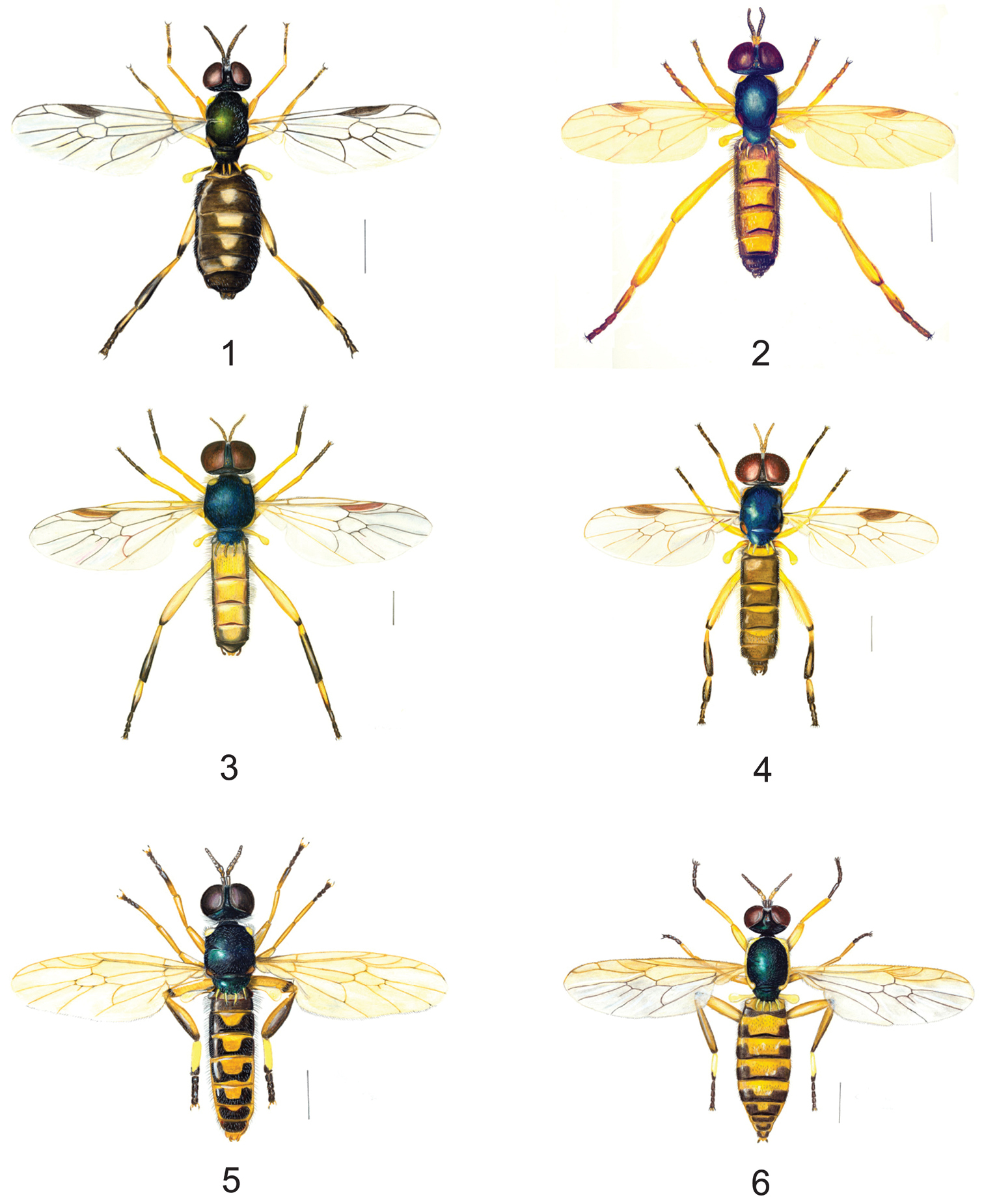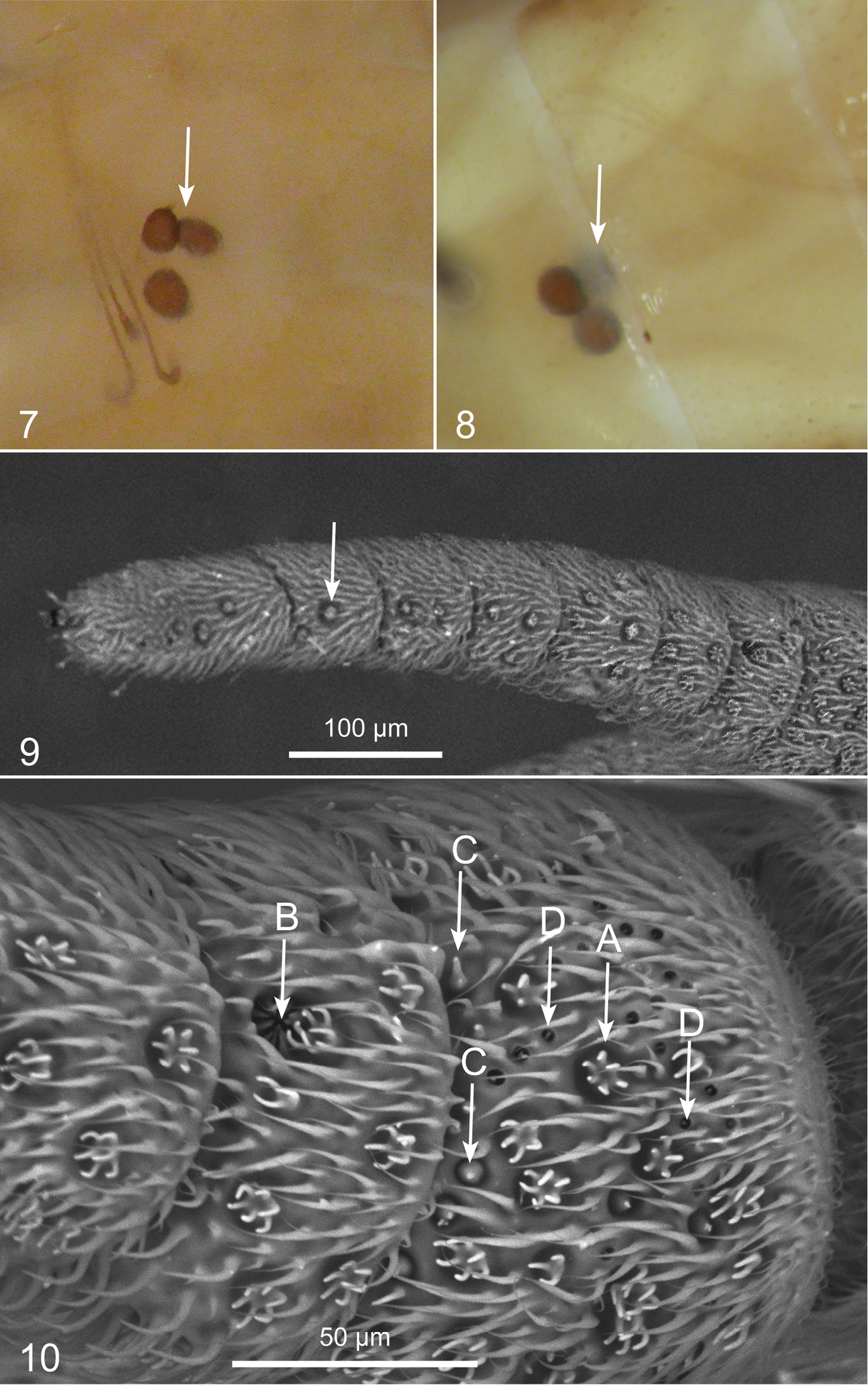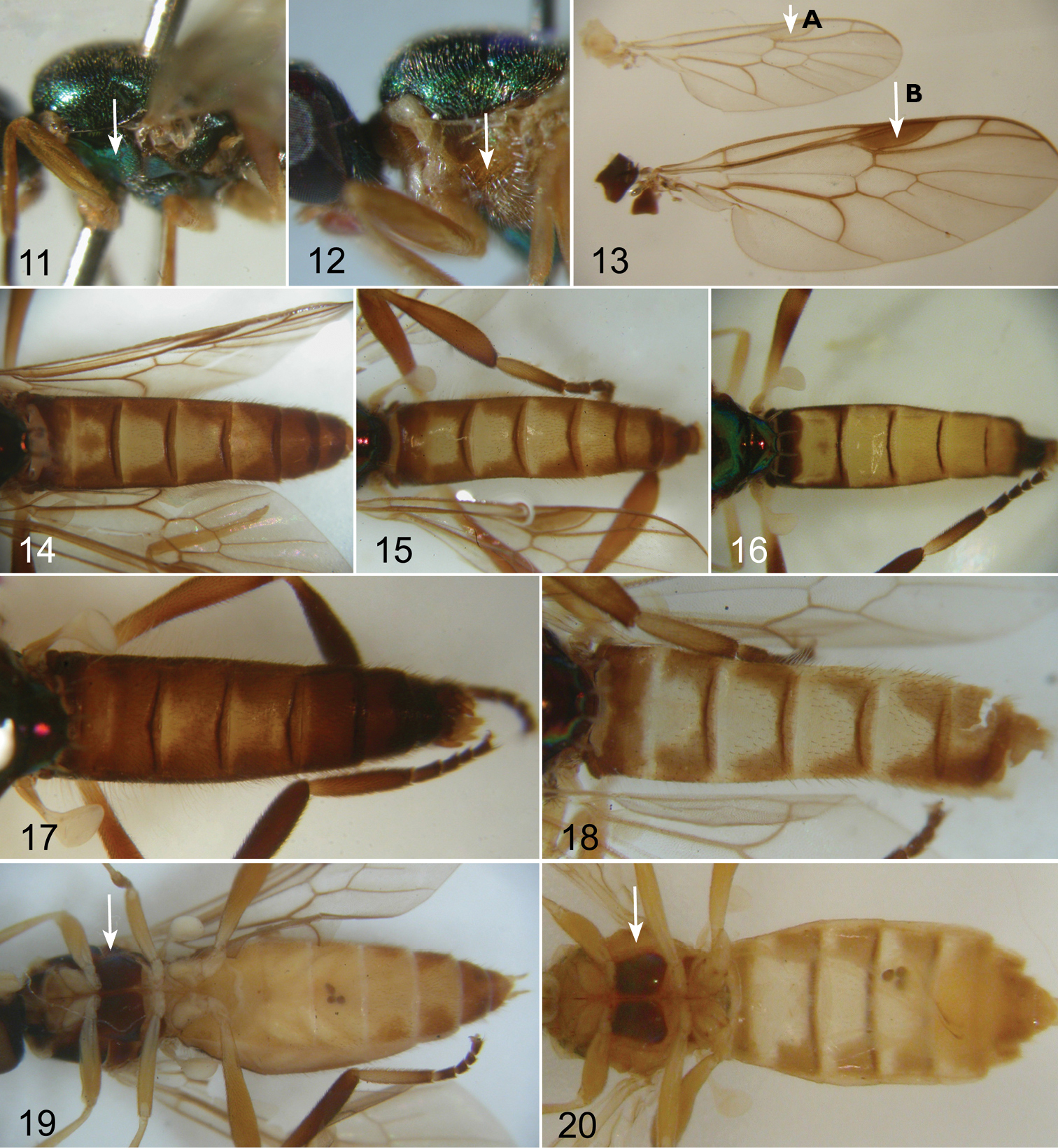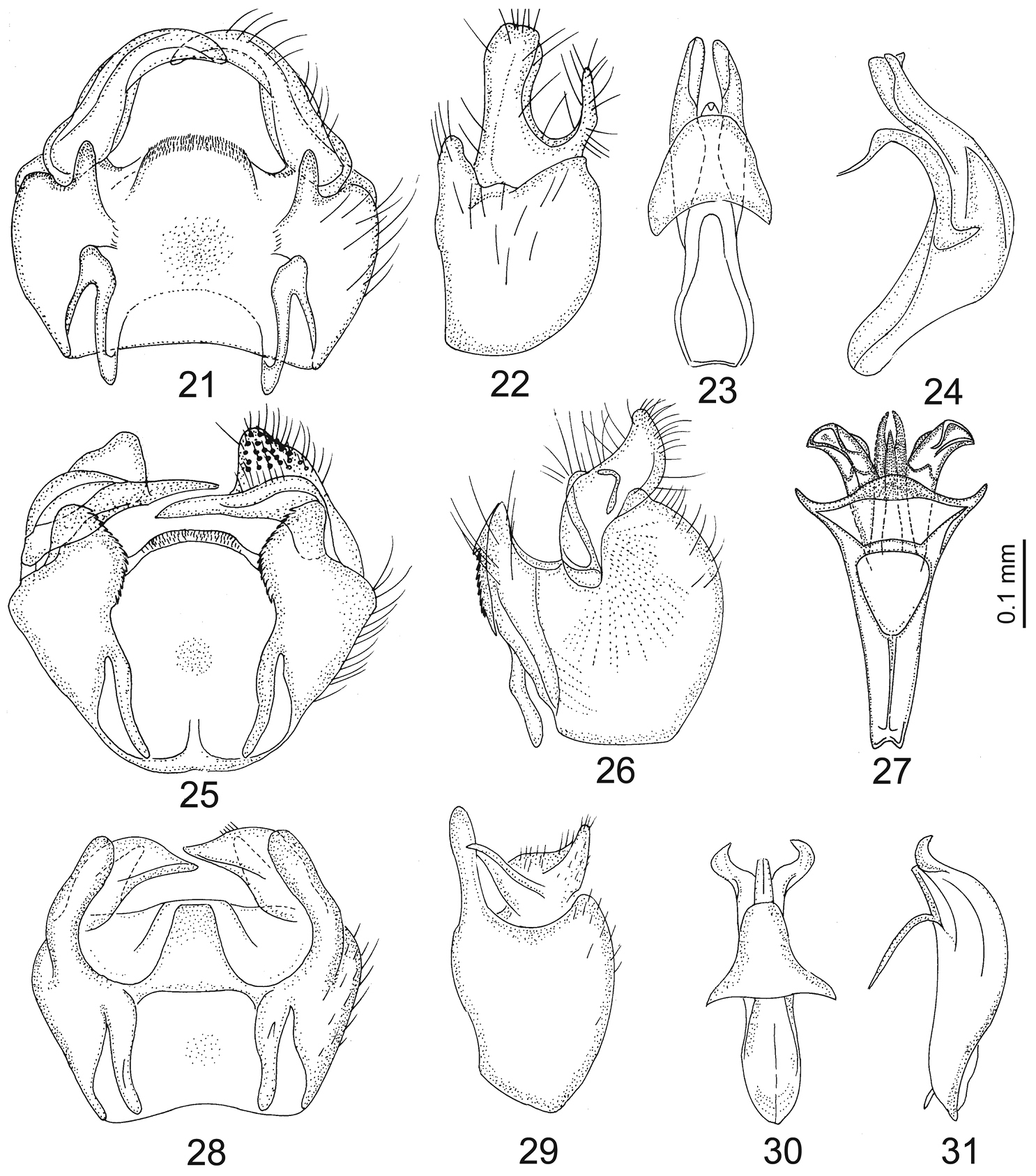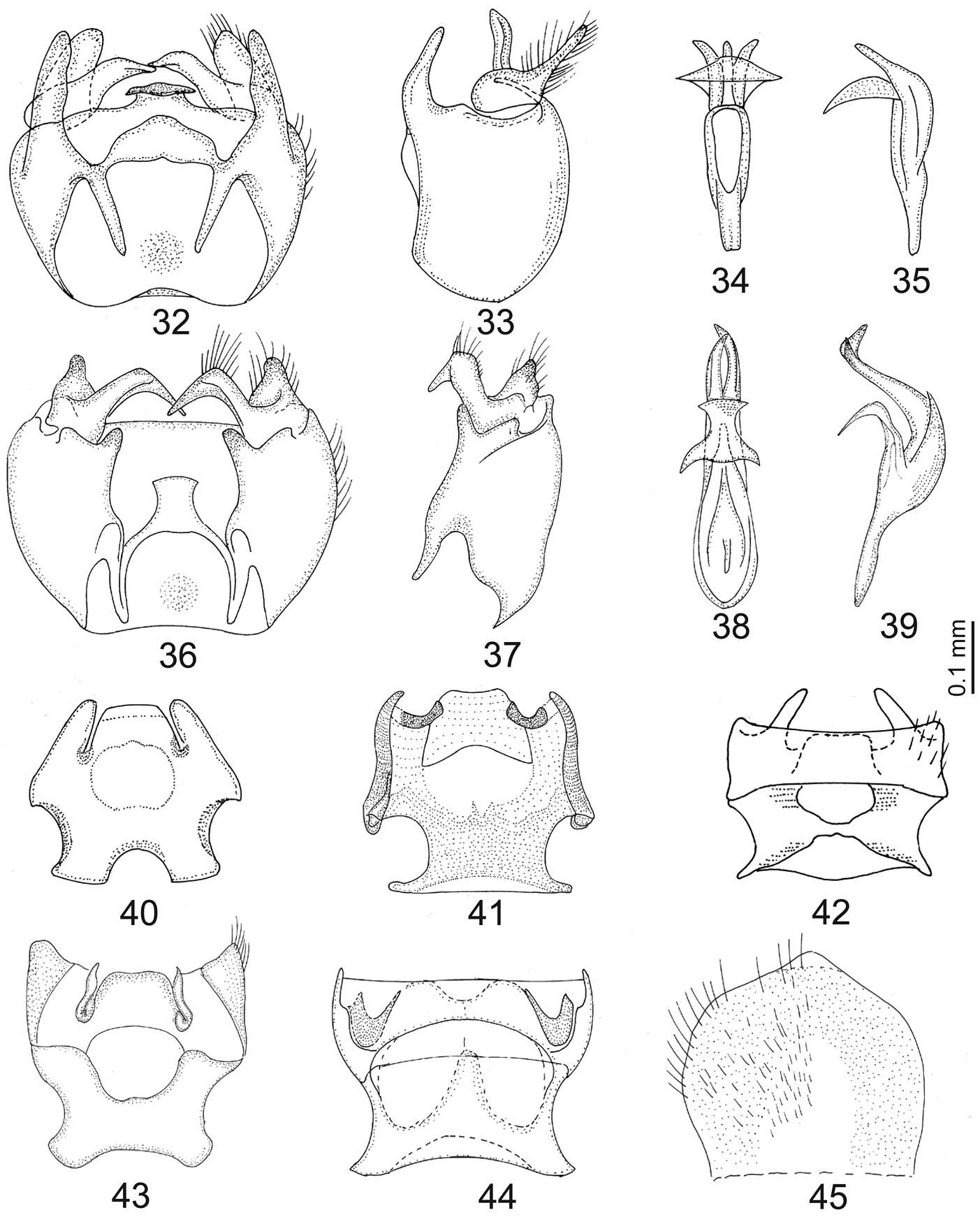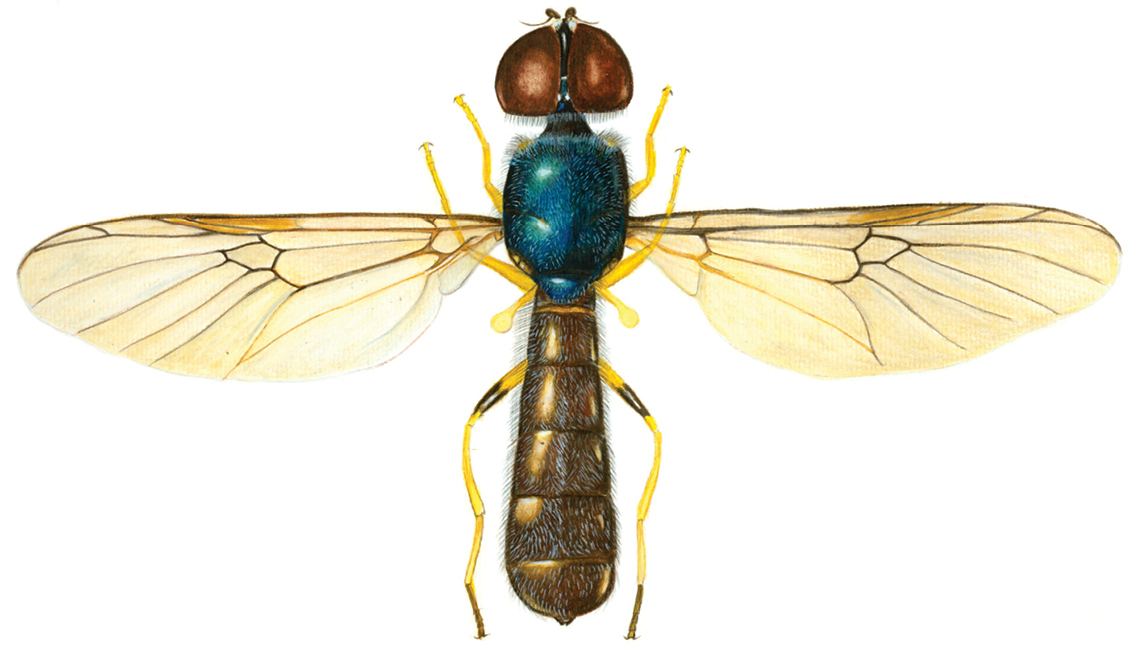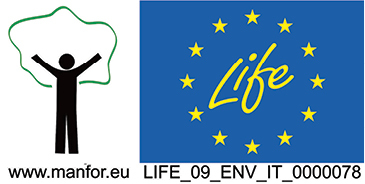






(C) 2013 Franco Mason. This is an open access article distributed under the terms of the Creative Commons Attribution License 3.0 (CC-BY), which permits unrestricted use, distribution, and reproduction in any medium, provided the original author and source are credited.
For reference, use of the paginated PDF or printed version of this article is recommended.
Citation: Mason F (2013) Updated Italian checklist of Soldier Flies (Diptera, Stratiomyidae). ZooKeys 336: 61–78. doi: 10.3897/zookeys.336.6016
An updated checklist for Stratiomyidae of Italy is presented. Previous knowledge and information are put together in a comprehensive way, integrated also with results obtained by sampling with Malaise traps in some of the test areas of the LIFE+ project ManFor C.BD.
At the time of writing, with 91 known species, the Italian fauna of Stratiomyidae is the richest in Europe. Neopachygaster meromelas (Dufour, 1841) and Zabrachia minutissima (Zetterstedt, 1838) are new to the Italian fauna. A comprehensive key to the European species of Chorisops Rondani, 1856 is given.
Italy, identification keys, faunistic, checklist, forest, Life Project
In the recent decades, stimulated by the monograph of
Updated Italian checklist of Stratiomyidae. Abbreviations: Italian administrative regions (cf.
| Taxa | N | S | Sa | Si | |||||||||||||||||
|---|---|---|---|---|---|---|---|---|---|---|---|---|---|---|---|---|---|---|---|---|---|
| Em | FVG | Li | Lo | Pi | TAA | VA | V | Abr | Ba | Ca | Cp | La | Ma | Mo | Pu | To | Um | Sa | Si | ||
| 1. | Actina chalybea Meigen, 1804 | • | • | • | • | • | • | ||||||||||||||
| 2. | Adoxomyia dahlii (Meigen, 1830) | • | • | • | • | • | |||||||||||||||
| 3. | Adoxomyia lindneri Dušek & Rozkošný, 1963 | • | • | ||||||||||||||||||
| 4. | Alliocera graeca Saunders, 1845 | • | |||||||||||||||||||
| 5. | Beris chalybata (Forster, 1771) | • | • | • | • | • | |||||||||||||||
| 6. | Beris clavipes (Linnaeus, 1767) | • | • | • | • | • | |||||||||||||||
| 7. | Beris fuscipes Meigen, 1820 | • | • | ||||||||||||||||||
| 8. | Beris geniculata Curtis, 1830 | • | • | • | |||||||||||||||||
| 9. | Beris morrisii Dale, 1841 | • | • | • | • | • | • | • | |||||||||||||
| 10. | Beris strobli Dušek & Rozkošný, 1968 | • | • | ||||||||||||||||||
| 11. | Beris vallata (Forster, 1771) | • | • | • | • | ||||||||||||||||
| 12. | Chloromyia formosa (Scopoli, 1763) | • | • | • | • | • | • | • | • | • | • | • | • | • | • | • | • | • | • | • | |
| 13. | Chloromyia speciosa (Macquart, 1834) | • | • | • | • | • | • | ||||||||||||||
| 14. | Chorisops caroli Troiano, 1995 | • | • | • | • | • | |||||||||||||||
| 15. | Chorisops masoni Troiano & Toscano, 1995 | • | • | • | • | • | |||||||||||||||
| 16. | Chorisops nagatomii Rozkošný, 1979 | • | • | • | • | • | • | • | |||||||||||||
| 17. | Chorisops tibialis (Meigen, 1820) | • | • | • | • | • | |||||||||||||||
| 18. | Chorisops tunisiae (Becker, 1915) | • | |||||||||||||||||||
| 19. | Clitellaria ephippium (Fabricius, 1775) | • | • | • | • | • | • | • | • | • | • | • | • | ||||||||
| 20. | Eupachygaster tarsalis (Zetterstedt, 1842) | • | • | • | • | • | • | ||||||||||||||
| 21. | Hermetia illucens (Linnaeus, 1758) | • | • | • | • | • | • | • | • | • | • | ||||||||||
| 22. | Lasiopa calva (Meigen, 1822) | • | |||||||||||||||||||
| 23. | Lasiopa krkensis Lindner, 1938 | • | |||||||||||||||||||
| 24. | Lasiopa pseudovillosa Rozkošný, 1983 | • | • | • | • | • | • | • | • | • | • | ||||||||||
| 25. | Lasiopa tsacasi Dušek & Rozkošný, 1970 | • | • | • | • | ||||||||||||||||
| 26. | Lasiopa villosa (Fabricius, 1794) | • | • | • | • | • | • | • | • | ||||||||||||
| 27. | Microchrysa flavicornis (Meigen, 1822) | • | • | • | • | ||||||||||||||||
| 28. | Microchrysa polita (Linnaeus, 1822) | • | • | • | • | • | • | ||||||||||||||
| 29. | Nemotelus (Camptopelta) nigrinus Fallén, 1817 | ||||||||||||||||||||
| 30. | Nemotelus (Nemotelus) anchora Loew, 1846 | • | • | ||||||||||||||||||
| 31. | Nemotelus (Nemotelus) argentifer Loew, 1846 | • | • | ||||||||||||||||||
| 32. | Nemotelus (Nemotelus) crenatus Egger, 1859 | • | • | ||||||||||||||||||
| 33. | Nemotelus (Nemotelus) cylindricornis Rozkošný, 1977 | • | |||||||||||||||||||
| 34. | Nemotelus (Nemotelus) lasiops Loew, 1846 | • | • | ||||||||||||||||||
| 35. | Nemotelus (Nemotelus) latiusculus Loew, 1871 | • | • | • | • | • | |||||||||||||||
| 36. | Nemotelus (Nemotelus) longirostris Wiedemann, 1824 | • | |||||||||||||||||||
| 37. | Nemotelus (Nemotelus) maculiventris Bigot, 1861 | • | |||||||||||||||||||
| 38. | Nemotelus (Nemotelus) nigrifrons Loew, 1846 | • | • | ||||||||||||||||||
| 39. | Nemotelus (Nemotelus) niloticus Olivier, 1811 | • | |||||||||||||||||||
| 40. | Nemotelus (Nemotelus) notatus Zetterstedt, 1842 | • | • | • | • | • | |||||||||||||||
| 41. | Nemotelus (Nemotelus) pantherinus (Linnaeus, 1758) | • | • | • | • | • | • | • | • | • | • | • | |||||||||
| 42. | Nemotelus (Nemotelus) proboscideus Loew, 1846 | • | |||||||||||||||||||
| 43. | Neopachygaster meromelas (Dufour, 1841) | • | |||||||||||||||||||
| 44. | Odontomyia angulata (Panzer, 1798) | • | • | • | • | • | • | • | • | • | • | • | |||||||||
| 45. | Odontomyia annulata (Meigen, 1822) | • | • | • | • | • | • | • | |||||||||||||
| 46. | Odontomyia argentata (Fabricius, 1794) | • | |||||||||||||||||||
| 47. | Odontomyia cephalonica Strobl, 1898 | • | |||||||||||||||||||
| 48. | Odontomyia discolor Loew, 1846 | • | • | • | • | ||||||||||||||||
| 49. | Odontomyia flavissima (Rossi, 1790) | • | • | • | • | • | • | ||||||||||||||
| 50. | Odontomyia hydroleon (Linnaeus, 1758) | • | • | • | • | • | • | • | • | • | • | ||||||||||
| 51. | Odontomyia ornata (Meigen, 1822) | • | • | • | • | • | • | • | • | ||||||||||||
| 52. | Odontomyia tigrina (Fabricius, 1775) | • | • | • | • | ||||||||||||||||
| 53. | Oplodontha viridula (Fabricius, 1775) | • | • | • | • | • | • | • | • | • | • | • | • | ||||||||
| 54. | Oxycera analis Wiedemann in Meigen, 1822 | • | • | • | • | ||||||||||||||||
| 55. | Oxycera fallenii Stæger, 1844 | ||||||||||||||||||||
| 56. | Oxycera germanica (Szilády, 1932) | • | • | • | |||||||||||||||||
| 57. | Oxycera leonina (Panzer, 1798) | • | • | • | • | • | • | • | |||||||||||||
| 58. | Oxycera locuples Loew, 1857 | • | • | • | • | • | |||||||||||||||
| 59. | Oxycera marginata Loew, 1859 | • | • | • | |||||||||||||||||
| 60. | Oxycera meigenii Stæger, 1844 | • | • | • | • | • | |||||||||||||||
| 61. | Oxycera morrisii Curtis, 1833 | • | • | • | • | ||||||||||||||||
| 62. | Oxycera muscaria (Fabricius, 1794) | • | |||||||||||||||||||
| 63. | Oxycera nigricornis Olivier, 1812 | • | • | • | • | • | • | • | • | • | |||||||||||
| 64. | Oxycera pardalina Meigen, 1822 | • | • | • | • | • | • | • | • | ||||||||||||
| 65. | Oxycera pseudoamoena Dušek & Rozkošný, 1974 | • | • | ||||||||||||||||||
| 66. | Oxycera pygmaea (Fallén, 1817) | • | • | • | |||||||||||||||||
| 67. | Oxycera rara (Scopoli, 1763) | • | • | • | • | • | • | ||||||||||||||
| 68. | Oxycera terminata Meigen, 1822 | • | • | • | |||||||||||||||||
| 69. | Oxycera trilineata (Linnaeus, 1767) | • | |||||||||||||||||||
| 70. | Oxycera varipes Loew in Heyden, 1870 | • | • | • | |||||||||||||||||
| 71. | Pachygaster atra (Panzer, 1798) | • | • | • | • | • | • | • | • | • | • | • | • | • | |||||||
| 72. | Pachygaster leachii Curtis, 1824 | • | • | • | • | • | • | • | |||||||||||||
| 73. | Sargus albibarbus Loew, 1855 | • | • | • | • | ||||||||||||||||
| 74. | Sargus bipunctatus (Scopoli, 1763) | • | • | • | • | • | • | • | • | • | • | ||||||||||
| 75. | Sargus cuprarius (Linnaeus, 1758) | • | • | • | • | • | • | • | |||||||||||||
| 76. | Sargus flavipes Meigen, 1822 | • | • | • | • | • | • | • | • | • | • | ||||||||||
| 77. | Sargus harderseni Mason & Rozkošný, 2008 | • | • | ||||||||||||||||||
| 78. | Sargus iridatus (Scopoli, 1763) | • | • | • | • | • | • | • | • | • | • | • | • | ||||||||
| 79. | Sargus rufipes Wahlberg, 1854 | • | • | • | |||||||||||||||||
| 80. | Stratiomys cenisia Meigen, 1822 | • | • | • | • | • | • | • | • | • | • | • | |||||||||
| 81. | Stratiomys chamaeleon (Linnaeus, 1758) | • | • | • | • | • | • | • | • | ||||||||||||
| 82. | Stratiomys concinna Meigen, 1822 | • | • | • | |||||||||||||||||
| 83. | Stratiomys equestris Meigen, 1835 | • | • | ||||||||||||||||||
| 84. | Stratiomys hispanica (Pleske, 1901) | • | |||||||||||||||||||
| 85. | Stratiomys longicornis (Scopoli, 1763) | • | • | • | • | • | • | • | • | ||||||||||||
| 86. | Stratiomys potamida Meigen, 1822 | • | • | • | • | • | • | • | • | ||||||||||||
| 87. | Stratiomys rubricornis (Bezzi, 1896) | • | • | • | • | ||||||||||||||||
| 88. | Stratiomys singularior (Harris, 1776) | • | • | • | • | • | • | ||||||||||||||
| 89. | Vanoyia tenuicornis (Macquart, 1834) | • | |||||||||||||||||||
| 90. | Zabrachia minutissima (Zetterstedt, 1838) | • | • | • | |||||||||||||||||
| 91. | Zabrachia tenella (Jaennicke, 1866) | • | • | ||||||||||||||||||
| Total | 37 | 19 | 29 | 25 | 38 | 39 | 10 | 32 | 32 | 9 | 14 | 6 | 44 | 10 | 2 | 14 | 26 | 6 | 26 | 28 | |
The larva of Neopachygaster meromelas has been described in detail by
Number of species of the Stratiomyidae in the Italian administrative regions. N = Northern Italy: Em = Emilia-Romagna, FVG = Friuli-Venezia Giulia, Li = Liguria, Lo = Lombardy, Pi = Piedmont, TAA = Trentino-Alto Adige, V = Venetia, Va = Val Val d'Aosta. S = Peninsular Italy: Abr = Abruzzo, Ba = Basilicata, Ca = Calabria, Cp = Campania, La = Latium, Ma = Marches, Mo = Molise, Pu = Apulia, To = Tuscany, Um = Umbria. Si = Sicily and small circum-Sicilian islands. Sa = Sardinia and small circum-Sardinian islands.
Venetia Region: Rovigo province, Porto Caleri, loc. Bosco Giardino, 45°05'N, 12°19'E, 12.viii–8.ix.2004, Malaise Trap, 2 ♀♀, D. Sommaggio leg. (FMCV); Emilia–Romagna, Ferrara province, Isola Bianca, LIPU Oasi, Retro Duna, 44°53'N, 11°38'E, 4.vii–1.viii.2004, Malaise Trap, 1 ♀, D. Sommaggio leg. (FMCV); Rovigo province, Porto Caleri, Bosco intermedio, 45°06'N, 12°19'E, 8.ix–1.x.2004, Malaise Trap, 1 ♀, D. Sommaggio leg. (FMCV); same data, but 20.vii–12.vii.2004, 1 ♀, (FMCV). Regione Veneto, Belluno province, Cellarda, Vincheto di Cellarda [State Nature Reserve], 230 m, UTM Latitude: 46°0'43"N, 11°58'32"E, 1–15.viii.2007, Window Trap T5 (cf.
Distribution. Zabrachia minutissima is a Eurasian species (
Hermetia illucens is new to Calabria (Reggio Calabria, Pellaro, 19.ix.2011, photo by Francesco D’Aleo (2012)). Stratiomys cenisia is new to Sicily (Trapani 20.v.2009), and Clitellaria ephippium is new to Marche (12.vii.2010, photo by Marco Paglialunga). All these data were posted in the “Forum Entomologi italiani” [Forum of Italian Entomologists] www.entomologiitaliani.net/forum (last accessed 16 April 2012).
The nomenclatorial history of the name Chorisops Rondani has been recently clarified by
In Europe, at the present time, five species of Chorisops are known: Chorisops caroli Troiano, 1995, Chorisops masoni Troiano & Toscano, 1995, Chorisops nagatomii Rozkošný, 1979, Chorisops tibialis (Meigen, 1820) and Chorisops tunisiae (Becker, 1915). Two of these, Chorisops caroli and Chorisops masoni, are probably endemic to Italy (
Chorisops, habitus: 1 Chorisops caroli Troiano, 1995 ♂ 2 Chorisops masoni Troiano & Toscano, 1995 ♂ 3 Chorisops nagatomii Rozkošný, 1979 ♂ 4 Chorisops tibialis (Meigen, 1820) ♂ 5 Chorisops tunisiae (Becker, 1915) ♂ 6 Chorisops tunisiae ♀, (drawns by Mason F). Scale bar = 1 mm.
As in other Beridinae (
7 Spermathecae of Chorisops tunisiae (Becker)8 Spermathecae of Chorisops tibialis (Meigen) 9 Antenna of Chorisops tunisiae (Becker) 10 External side of the first (basal) flagellomere of Chorisops tunisiae (Becker). Antennal sensilla: A finger-like B sunken finger-like C subconical D stick-like.
Despite the availability of a relatively large amount of newly collected material of Chorisops, I have not been able to find any reliable external character of diagnostic value, except for the different colouring of the anepisternum and postpronotal callus (cf. Figs 11 and 12) and in the relative darkening of the wing pterostigma (Figs 13A, 13B). A reliable identification is possible only by examining the genitalia of both sexes.
11 Thorax in lateral view of Chorisops nagatomii Rozkošný 12 Thorax in lateral view of Chorisops tunisiae (Becker) 13 Wing pterostigma: A Chorisops tunisiae (Becker) B Chorisops tibialis (Meigen) 14–18 Male abdomen (dorsal view) of: 14 Chorisops caroli Troiano 15 Chorisops masoni Troiano & Toscano 16 Chorisops nagatomii Rozkošný 17 Chorisops tibialis (Meigen) 18 Chorisops tunisiae (Becker) 19–20 Male abdomen (ventral view) of: 19 Chorisops tibialis (Meigen) 20 Chorisops tunisiae (Becker).
| 1 | Pterostigma light yellow (Fig. 13A) | Chorisops tunisiae (Becker) |
| – | Pterostigma usually darker (Fig. 13B) | 2 |
| 2 | Abdominal tergites mainly brown (Figs 5, 17) | Chorisops tibialis (Meigen) |
| – | Tergites with more extensive yellow pattern (Figs 2, 3, 4, 6) | 3 |
| 3 | Tergites with only a narrow brown preapical grooves (Figs 4, 16); genitalia as in Figs 28–31 | Chorisops nagatomii Rozkošný |
| – | Tergites with different colour pattern (Figs 2, 3, 14, 15) | 4 |
| 4 | Scutum shining green; genitalia as in Figs 25–27 | Chorisops masoni Troiano & Toscano |
| – | Scutum shining blue; genitalia as in Figs 21–24 | Chorisops caroli Troiano |
Chorisops caroli: 21 Genital capsule 22 Genital capsule (lateral view)23 Aedeagal complex 24 Aedeagal complex (lateral view) 25–27 Chorisops masoni: 25 Genital capsule 26 Genital capsule (lateral view) 27 Aedeagal complex (ventral view) 28–31 Chorisops nagatomii: 28 Genital capsule 29 Genital capsule (lateral view) 30 Aedeagal complex (ventral view) 31 Aedeagal complex (lateral view); (redrawn from
| 1 | Pterostigma light yellow (Fig. 13A), anepisternum and postronotal callus yellow (Fig. 12), pleural sclerites bright yellow, except for the contrastingly black katepisternum (Fig. 20) | Chorisops tunisiae (Becker) |
| – | Pterostigma darker (Fig. 13B), anepisternum shining green (Fig. 11), pleural sclerites always dark (Fig. 19) | 2 |
| 2 | Genital furca with rounded corners (Figs 40, 42) | 3 |
| – | Genital furca with pointed corners (Figs 41, 43) | 4 |
| 3 | Genital furca massive, laterally enlarged, with a rounded median aperture (Fig. 40) | Chorisops caroli Troiano |
| – | Genital furca with a relatively wide transverse median aperture (Fig. 42) | Chorisops nagatomii Rozkošný |
| 4 | Genital furca with developed lateral wings (Fig. 41) | Chorisops masoni Troiano |
| – | Genital furca without developed lateral wings (Fig. 43) | Chorisops tibialis (Meigen) |
Chorisops tibialis: 32 Genital capsule 33 Genital capsule (lateral view) 34 Aedeagal complex 35 Aedeagal complex (lateral view) 36–39 Chorisops tunisiae: 36 Genital capsule 37 Genital capsule (lateral lateral view) 38 Aedeagal complex 39 Aedeagal complex (lateral view) 40–44 Genital furca of: 40 Chorisops caroli 41 Chorisops masoni 42 Chorisops nagatomii 43 Chorisops tibialis 44 Chorisops tunisiae 45 Sugenital plate of Chorisops tunisiae; (redrawn from
With newly recorded Eupachygaster meromelas and Zabrachia minutissima, the Italian fauna includes at the present time 91 species. The species probably endemic to Italy are: Chorisops caroli, Chorisops masoni and Sargus harderseni (Fig. 46), the last recently described (
Habitus of Sargus harderseni Mason & Rozkošný, 2008 (♂), (drawn by Mason F).
Thanks are due to Rudolf Rozkošný (Brno, Czech Republic), Norman E. Woodley (Washington, USA) and Martin Hauser (Sacramento, USA), who kindly review the manuscript and the English. Daniele Birtele, Maurizio Mei (Rome, Italy), Roberto Poggi (Genova, Italy), Daniele Sommaggio (Ferrara, Italy) and Stefano Vanin (Huddersfield, UK) kindly provided some interesting material for this study. Massimo Lopresti (Verona, Italy) enhanced the quality of the figures and composed the tables. Part of the work that contributed to this publication has been funded in the framework of the project LIFE09 ENV/IT/000078 ManFor C.BD. “Managing forests for multiple purposes: carbon, biodiversity and socio–economic wellbeing”, coordinated by G. Matteucci CNR–IBAF, Rome, Italy. Thanks are due also to Alessandro Bottacci (Italian National Forest Service, Biodiversity Office, Rome) and Augusto Vigna Taglianti (University "La Sapienza", Rome) for their support to this research and to two anonymous reviewers for helpful comments on a earlier version of the manuscript.
Diptera Stratiomyidae, identified by Mason F. 2012 and 2013. (doi: 10.3897/zookeys.336.6016.app) File format: Microsoft Excel file (xls).
Explanation note: Diptera Stratiomyidae collected by Malaise trap in the framework of the Project LIFE_09_ENV_IT_0000078.
